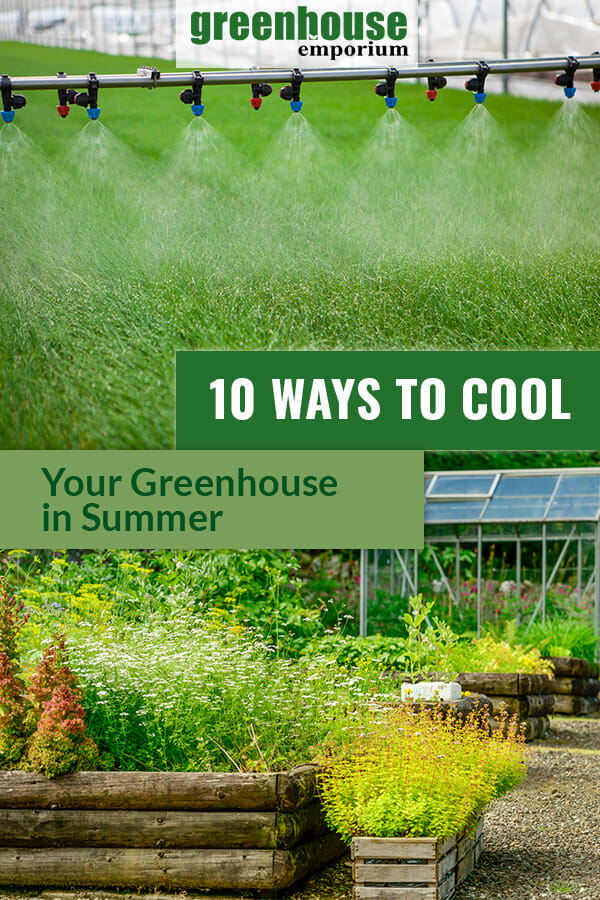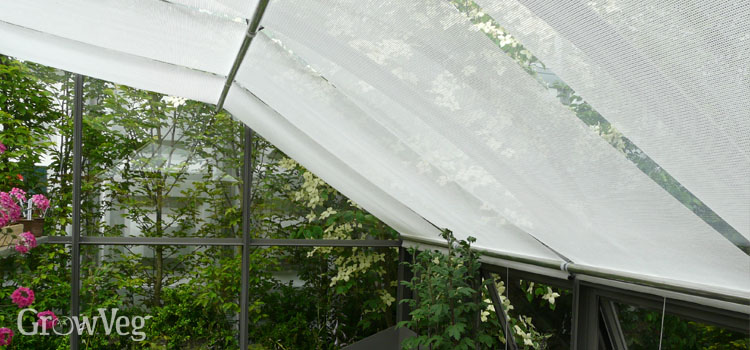To keep a greenhouse cool in the summer, ventilation, shading, and proper watering techniques are essential. A greenhouse is a controlled environment designed to nurture plants and promote their growth.
However, during the hot summer months, excessive heat can become a challenge. High temperatures inside the greenhouse can lead to wilting, reduced plant productivity, and even plant loss. Fortunately, there are several effective methods to keep a greenhouse cool and maintain an optimal growing environment.
This article will explore various techniques to achieve this, including the importance of ventilation, the use of shading, and appropriate watering practices. By following these strategies, greenhouse owners can ensure that their plants thrive even in the scorching summer heat. Let’s delve into the details of how to maintain a cool and comfortable environment inside a greenhouse during the summer season.

Credit: greenhouseemporium.com
Understanding The Importance Of Cooling A Greenhouse
It is important to understand the significance of cooling a greenhouse in order to keep plants healthy. High temperatures can have detrimental effects on plants, making it crucial to maintain a cool environment. Excessive heat can cause wilting, stunted growth, and even death for many plant varieties.
By implementing effective cooling methods, you can create an optimal growing environment for your plants. Some strategies include proper ventilation, shading, using evaporative cooling techniques, and incorporating fans or air conditioning systems. Ventilation allows for the exchange of hot air with fresh, cooler air, while shading provides protection from direct sunlight.
Evaporative cooling methods, such as misting or using evaporative pads, can help lower the temperature inside the greenhouse. With these measures in place, you can ensure that your greenhouse remains cool, thereby promoting healthy plant growth.

How to Keep a Greenhouse Cool in the Summer: Step by Step Guide
Optimal Air Circulation For Temperature Control
Proper ventilation is of utmost importance when it comes to keeping a greenhouse cool in the summer. To optimize air circulation and regulate temperature, various strategies can be employed. Using fans or vents is one effective method. These devices help to circulate the air inside the greenhouse, preventing heat from building up.
Positioning the fans strategically is also crucial. By placing them near the vents or on opposite sides of the greenhouse, you can create a cross-ventilation effect, ensuring proper air movement throughout. This ensures that the hot air is expelled and replaced with cooler air, maintaining ideal conditions for your plants.
With these measures in place, you can effectively keep your greenhouse cool during the summer months, promoting healthy plant growth and ensuring optimal conditions for cultivation.
Shading Techniques To Reduce Heat
Keeping a greenhouse cool during the hot summer months is crucial for maintaining the optimal growing conditions. One effective approach is to use shading techniques to reduce heat. Shading offers a range of benefits in a greenhouse. Several types of shading materials can be used, such as shade cloths, blinds or curtains, and paint or whitewash.

These materials block out excess sunlight and lower the temperature inside the greenhouse. The proper installation and management of shading materials are important to ensure their effectiveness. By strategically placing shading materials and adjusting them as needed, greenhouse owners can create a cooler environment for their plants, preventing heat stress and promoting healthy growth.
With these shading techniques in place, greenhouse growers can optimize their summer harvests and ensure the well-being of their plants.
Effective Use Of Evaporative Cooling
Evaporative cooling is an effective way to keep a greenhouse cool in the summer. By understanding the science behind this cooling method, you can use it in the most efficient manner. Utilizing misting systems is one way to achieve effective evaporative cooling.
These systems release a fine mist of water into the air, which evaporates and cools down the greenhouse. There are different types of misting systems available, so you can choose the one that suits your needs best. Proper positioning and regular maintenance of the misting system is crucial to ensure optimal performance.
Additionally, using evaporative cooling pads can further enhance the cooling process. These pads are placed inside the greenhouse and absorb water, releasing cool air as it evaporates. Overall, incorporating evaporative cooling techniques can help you maintain a cool and comfortable environment in your greenhouse during the hot summer months.
Thermal Mass For Temperature Regulation
Thermal mass is a crucial element in keeping a greenhouse cool during the summer. By utilizing materials with high thermal mass, such as water barrels or containers, and stone or concrete floors, heat can be absorbed and released efficiently. Proper placement and management of these thermal mass materials are key factors in regulating temperature.

It is important to avoid starting any sentence with overused phrases in order to maintain a unique and engaging writing style. By following these guidelines, you can optimize your greenhouse’s cooling system and ensure a comfortable environment for your plants, without relying on additional cooling methods.
Insulation Strategies To Maintain Cool Temperatures
Maintaining cool temperatures in a greenhouse during the summer is crucial to ensure optimal plant growth. Insulation plays a vital role in achieving this goal. Various types of insulation materials can be used, including bubble wrap, reflective foil, and insulated panels.
These materials effectively insulate the walls, roof, and doors of the greenhouse. Bubble wrap creates a layer of trapped air, assisting in temperature control, while reflective foil reflects heat away from the greenhouse. Insulated panels provide superior insulation, preventing heat transfer.
Properly insulating the greenhouse helps to keep temperatures down even during hot summer days. By implementing these insulation strategies, greenhouse owners can create a comfortable environment for plants, allowing them to thrive and reach their full potential. So, if you’re wondering how to keep a greenhouse cool in the summer, insulation is the answer.
Smart Use Of Shade-Loving Plants
Strategically incorporating shade-tolerant plants in the greenhouse is a smart way to keep it cool during the summer. By strategically placing these plants, you can achieve better temperature regulation and avoid overheating. Some of the benefits of using shade-loving plants include reducing the amount of direct sunlight that enters the greenhouse, preventing excessive heat build-up, and creating a more comfortable environment for other plants.

There are various types of plants that thrive in shaded environments, such as ferns, hostas, and coleus. These plants not only provide shade but also add aesthetic appeal to your greenhouse. By carefully selecting and arranging these shade-loving plants, you can create a cool and pleasant atmosphere inside your greenhouse, allowing your other plants to thrive in optimal conditions.
Monitoring And Managing Humidity Levels
Monitoring and managing humidity levels is essential to keep a greenhouse cool during the summer. Understanding the impact of humidity on temperature is the first step in this process. Measuring and monitoring humidity levels regularly allows for adjustments to be made accordingly.
Strategies for controlling humidity, such as proper ventilation and the use of dehumidifiers, can be implemented to maintain an optimal level. Adjusting ventilation, opening windows, or using fans can help regulate humidity levels. Additionally, the use of dehumidifiers can efficiently remove excessive moisture from the air.

By taking these measures, greenhouse owners can ensure a cooler and more comfortable environment for their plants during the hot summer months.
Efficient Cooling System Maintenance
To keep a greenhouse cool in the summer, ensuring efficient maintenance of the cooling system is crucial. Cleaning and maintaining fans, vents, and misting systems should be a top priority. Regular inspections are necessary to identify and replace any faulty cooling system components.
By adhering to these maintenance practices, the greenhouse can maintain optimal cooling levels throughout the hot summer months. These steps are essential for preventing overheating and creating a favorable environment for plants to thrive. Neglecting cooling system maintenance can result in poor ventilation and inadequate temperature control, impacting the overall health of the greenhouse.
So, it is essential to prioritize regular maintenance to ensure a cool and comfortable atmosphere for plant growth.
Additional Tips For Greenhouse Cooling
To keep a greenhouse cool during the summer, there are additional tips you can follow. Use reflective materials to minimize heat absorption. Manage water usage and irrigation. Utilize natural shading from nearby structures or trees. These strategies help in maintaining a comfortable temperature for the plants inside your greenhouse.

Reflective materials like white paint or shade cloth can reduce heat absorption. Properly managing water usage and irrigation ensures the plants receive adequate moisture without excessive humidity. Additionally, taking advantage of natural shading from nearby structures or trees provides a cooling effect and protects the plants from direct sunlight.
By implementing these tips, you can successfully keep your greenhouse cool in the summer and create the ideal growing environment for your plants.
Frequently Asked Questions For How To Keep A Greenhouse Cool In The Summer
How Can I Cool Down My Greenhouse In The Summer?
To cool down your greenhouse in the summer, you can use shade cloth, install ventilation fans, misting systems, or evaporative coolers. Proper air circulation and shading can help maintain a cooler temperature inside the greenhouse.
Is It Necessary To Insulate A Greenhouse For Summer Cooling?
Insulating a greenhouse is not necessary for summer cooling. Instead, focus on providing proper shade, ventilation, and air circulation to keep the greenhouse cool during the hot summer months.
What Is The Ideal Temperature Range For A Greenhouse In The Summer?
The ideal temperature range for a greenhouse in the summer is typically between 75°f and 85°f (24°c and 29°c). This range allows for optimal plant growth while avoiding excessive heat stress.
How Often Should I Water Plants In A Cooled Greenhouse?
The frequency of watering plants in a cooled greenhouse depends on various factors such as plant type, size, and weather conditions. Generally, aim to water when the top inch of soil feels dry, but avoid overwatering as it can lead to root rot and other issues.
Can I Use Shade Cloth Alone To Cool My Greenhouse In The Summer?
Shade cloth alone might not be sufficient to cool a greenhouse in the summer. It is more effective when combined with other cooling methods like ventilation, fans, or misting systems. The shade cloth helps reduce direct sunlight and prevent overheating.
Conclusion
Keeping a greenhouse cool in the summer can be achieved through a combination of strategic measures to control temperature and humidity. Proper ventilation and shade can significantly alleviate the heat buildup inside the greenhouse. Utilizing shade cloth, installing vents, and using fans can help circulate fresh air and prevent overheating.
Additionally, employing appropriate watering techniques, such as misting or drip irrigation, can help maintain optimal moisture levels. Insulating the greenhouse with reflective materials and using shading paints can further minimize heat absorption. Regularly monitoring and adjusting temperature and humidity levels is essential to ensure a conducive environment for plants to thrive.
By implementing these practical strategies, greenhouse owners can effectively combat the challenges of summer heat and create an ideal growing environment for their plants. Keep your greenhouse cool, and your plants will thank you with healthy growth and abundant harvests.

